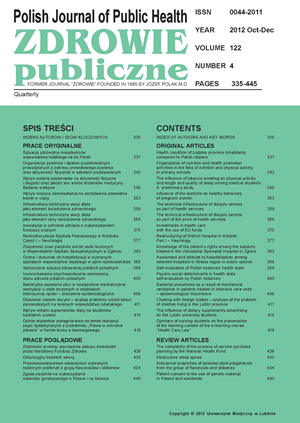Obstructive sleep apnea
DOI:
https://doi.org/10.12923/j.0044-2011/122-4/a.18Keywords:
obstructive sleep apnea, classification, prevalence, riskAbstract
Obstructive sleep apnea (OSA) is a disease characterized by the occurrence of at least five 10-second pauses in breathing (apnea) or abnormally low breathing events (hypopnea) accompanied with a decrease in blood oxygen saturation by 2-4% per hour of sleep, despite continued, or even intensified, movements of respiratory muscles.
OSA is diagnosed in 4% of men and 2% of women who develop the disease later, usually after the menopause. The severity of the disease is assessed with Apnea Hypopnea Index (AHI) indicating the average number of apneas and hypopneas per hour of sleep. OBS is a multicausal disease. The reported risk factors include: obesity, anatomical and post-inflammatory abnormalities in the structure of upper respiratory tract, inappropriate sleep hygiene, maxillary and mandibular deficiencies. The disease may lead to numerous life-threatening complications.
Maintaining a correct body mass, good sleep hygiene, rational use of hypnotic drugs and appropriate surgical-orthodontic treatment of patients with malocclusions and anatomic craniofacial anomalies are the basic principles of preventing OBS in patients prone to this disease.
References
1. Gastaut H, Tassarini C, Duron B. Etudes polisomnografiques des manifestations episodiques (hypniques et respiratiores) du syndrome Pickwick. Rev Neurol. 1965;112:568-79.
2. Jung R, Kuhlo W. Neurolophysiological studies of abnormal night sleep and the Pickwician syndrome. Prog Brain Res. 1965;18:140-59.
3. McNicolas WT. Diagnosis of obstructive sleep apnea in adults. Proc Am Thorac Soc. 2008;5:154-60.
4. Doherty LS, Cullem JP, Nolan P i wsp. The human genioglossus response to negative airway pressure: stimulus timing and route of delivery. Exp Physiol. 2008;93:288-95.
5. American Academy of Sleep Medicine Task Force. Sleep-related breathing disorders in adults: recommendations for syndrome definition and measurement techniques in clinical research. Sleep. 1999;22:667-89.
6. Lugaresi E, Cirignotta F, Gererdi R i wsp. Snoring and sleep apnea: natural history of heavy snorers disease. New York: Raven Press; 1990. p.25-36.
7. Young T, Finn L, Austin Di wsp. Menopausal status and sleep-disordered breathing in the Wisconsin Sleep Cohort Study. Am J Resp Crit Care Med. 2003;167:1181-5.
8. Whittle AT, Marshal I, Mortimore IL i wsp. Neck soft tissue and fat distribution: comparison between normal men and women by magnetic resonance imaging. Thorax. 1999;59:323-8.
9. Malhotra A, Huang Y, Fogel RBi wsp. The male predisposition to pharyngeal collapse: importance of airway length. Am J Resp Crit Care Med. 2002;166:1388-95.
10. Guilleminault C, Quera-Salva M, Partinen M i wsp. Women and the obstructive sleep apnea syndrome. Chest. 1988;93:104-9.
11. Ojoo JC, Kastelik JA, Morice AH. The respiratory system and the menopause. Menopause Int. 2001;7:168-73.
12. Schneider BK, Pickett CK, Zwillich CW i wsp. Influence of testosterone on breathing during sleep. J Appl Physiol. 1986;61:618-23.
13. Ip MSM, Lam B, Lauder IJ i wsp. A community study of sleep-disordered breathing in middle-aged Chinese men in Hong Kong. Chest. 2001;119:62-9.
14. Young T, Peppard PE, Gottlieb DJ. Epidemiology of obstructive sleep apnea: a population health perspective. Am J Crit Care Med. 2002;165:1217-39.
15. Ancoli-Israel S, Klauber MR, Stepnowsky C i wsp. Sleep disordered breathing in African-American elderly. Am J Respir Crit Care Med. 1995;152:1946-9.
16. Vgontzas AN, Pepanicolaou DA, Bixler EO i wsp. Sleep apnea and daytime sleepiness and fatigue: relation to visceral obesity, insulin resistance and hypercytokinemia. J Clin Endocrinol Metab. 2000;85:1151-8.
17. Krieger J. Clinical presentations of sleep apnoea. Eur Respir Mon. 1998;3:75-105.
18. Davies RJ, Stradling JR. The relationship between neck circumference, radiographic pharyngeal anatomy and the obstructive sleep syndrome. Eur Respire J. 1990;3:509-14.
19. Davies RJ, Ali NJ, Stradling RJ. Neck circumference and other clinical features in the diagnosis of the obstructive sleep apnoea syndrome. Thorax. 1992;5:377-81.
20. Rola R. Zaburzenia oddychania w czasie snu (ZOPS) u pacjentów z udarem niedokrwiennym mózgu i zaburzeniami krążenia mózgowego. Warszawa: Instytut Psychiatrii i Neurologii; 2010.
21. Zieliński J, Pływaczewski R, Bednarek M. Zaburzenia oddychania w czasie snu. Warszawa: Wydawnictwo Lekarskie PZWL; 1997.
22. Heinzer RC, Stanchina ML, Malhotra A i wsp. Effect on increased lung volume on sleep disordered breathing in patients with sleep apnoea. Thorax. 2006;61:435-9.
23. Orr WC, Martin JR. Obstructive sleep apnea associated with tonsillar hypertrophy in adults. Arch Intern Med. 1981;141:990-2.
24. Cistulli PA, Richards GN, Palmisano RG i wsp. Influence of maxillary constriction on nasal resistance and sleep apnea severity in patients with Marfan’s syndrome. Chest. 1996;110:1184-8.
25. Kushida CA, Efron B, Guilleminoult C. A predictive morphometric model for the obstructive sleep apnea syndrome. Ann Intern Med. 1997;127:581-7.
26. Seto BH, Gotsopoulos H, Sims MR i wsp. Maxillary morphology in obstruc-tive sleep apnoea syndrome. Eur J Orthod. 2001;23:703-14.
27. Teschler H, Berthon-Jones M, Wessendorf T i wsp. Influence of moderate alcohol consumption on obstructive sleep apnea with and without AutoSet nasal CPAP therapy. Eur Respir J. 1996;9:2371-7.
28. Wetter DW, Smith SS, Kenford SL i wsp. Smoking outcome expectancies: factor structure, predictive validity, and discriminant validity. J Abnorm Psychol. 1994;103:801-11.


